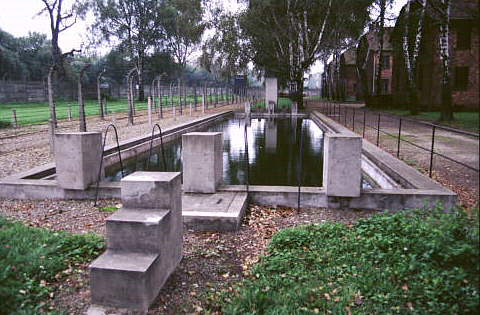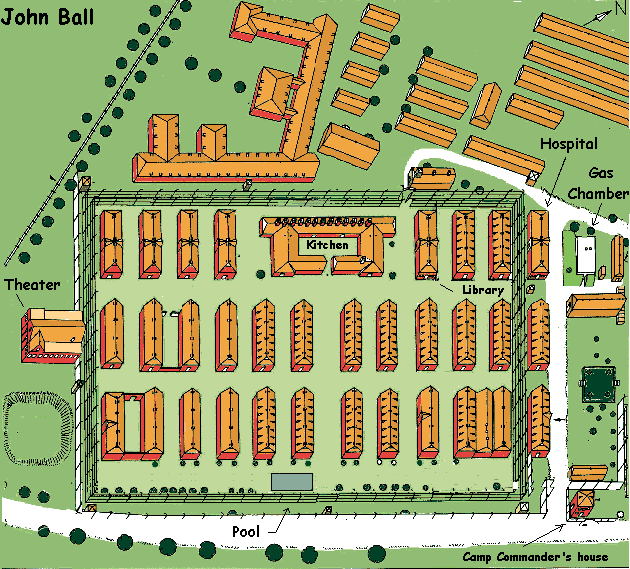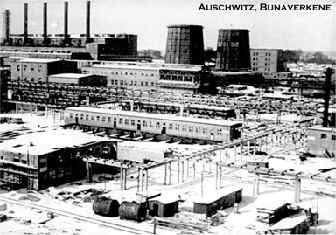School Trips to Auschwitz
How is it “hate” to suggest there is evidence that millions of people were not murdered?—Kurt Bechle, United States
I am shocked that in what I always thought to be “liberal” and “open-minded” Europe, anyone could be convicted for voicing an opinion regarding history.—Dominique Amarante, United States
- The word Holocaust has to mean a fiery sacrifice of some kind, as it does in the Bible. In the 20th century this term could well allude to the incineration of German cities by the UK and US, with up to one million intentional civilian deaths.
- Is it a crime, to believe the data? The primary evidence for the number of Jews who died in German concentration camps lies in the archives of Bad Arolsen, in Northern Germany. That archive has detailed records over half a century with over 50 million pages of documents about people who were in German camps during the war, accumulated over six decades. Maintained by the International Tracing Service and administered by the International Committee of the Red Cross, it has been used to validate all claims of holocaust-survivors and in checking of lost ones. These archives are now becoming available.
- No other source for this vital data exists. And yet, the totals that derive from these vast archives cannot be found in any English-language published volume! This is the most important thing. I know of only two books, one French and one German, that cite these totals. Georges Theil in Heresy cites the Arolsen total as 291,594 wartime deaths, and from this he derives a total of 'authenticated deaths in all the Hitlerite camps of detainees of Jewish origin' as under 200,000.[1] He is in jail, for publishing this volume.
- Germar Rudolf's volume had cited a similar figure, however he in addition surmised that there may have been a comparable number of such deaths that were non-authenticated. Thereby he reached a total figure of double this: 'A realistic estimate of the actual number of victims, therefore, may be twice as high as the total of victims registered by name in the records at Arolsen.'[2] This volume has been banned and burnt throughout Germany and its brilliant Editor is [was, ed.] in jail.
- Thus, the published figures, for Jewish deaths in German labour-camps, that are based on the data-source available and not on mere conjecture, are twofold, and they differ by 100%. Only relatively recently have these definitive Arolson totals become publicly available.
- In the case of Auschwitz, one has an independent check of mortality, a consequence of the high-water table around this camp. Burial of corpses was impossible there as it polluted the water supply, and so all bodies had to be cremated. Records exist for the quantity of coke used in the cremation-ovens. These records are intact over a two-year period around 1942, from which the quantity of cremations can be computed. Figures concordant with the Arolsen totals are thereby obtained.
- How many deaths were due to cyanide poisoning, in the German labour-camps? There exist two independent sources for this. The US Army consultant pathologist Dr Charles Larsen was sent over to Dachau and other German labour camps, at the end of WWII in 1945, to check out the piles of bodies, and ascertain what their causes of death may have been. They had been due, he reported, to famine and to outbreaks of typhus. He was put under quite a bit of pressure to state otherwise, that the deaths had been due to cyanide poisoning – but, he refused to do so. See his biography, Crime Doctor.[3]
- More recently, the Archival manager of Arolsen has given an answer to this question, concerning the number deaths recorded as having been due to cyanide poisoning. He replied:[4]
“unfortunately, we cannot reference a single document listing the death of a detainee due to gassing by Zyklon-B. As a rule, the Nazis gave other causes of death for inmates, who perished in the concentration camps.
With kind regards,
U. Jost, Archival Manager”
One is puzzled that such news should be regarded as unfortunate.
- Chemical evidence, concerning cyanide compounds remaining in the walls of Auschwitz, provides the best memory which the human race now has, concerning what happened there sixty years ago. Cyanide gas reacts and bonds very permanently with iron in brickwork. The German labour-camps had efficient cyanide gas-chambers, for delousing mattresses and clothes etc. Generally speaking, no-one promoting “the Holocaust” ever suggests they were used for gassing humans – because they were rather too small, and also they had intricate apparatus, as would have been broken by asphyxiating humans. Instead, it has always been proposed that buildings designated in German design-plans as washrooms or morgues had that function. The problem is, that their walls have no significant elevation of cyanide above background levels; whereas the walls of the delousing chambers have enormously high cyanide levels: the difference is three orders of magnitude. This suggests – no, it proves – that the Zyklon-B cyanide was used exactly where the German design-plans indicate that it was to be used: in order to save lives not to take them.[5]
- The UK Government funds compulsory trips to Auschwitz (two sixth-formers from every school to go each year) and teaching of ” the Holocaust ” is compulsory in secondary schools between the ages of 11 and 14. What a pity that they are not taken to see the gas-chambers, in these visits. Thirty million have trooped through a postwar-reconstructed washroom at Auschwitz – with its postwar-built big chimney beside it, that has no connection at all to the main building; but alas they are not taken to see the blue, blue walls of the Birkenau delousing-rooms, i.e. the gas-chambers. It does seem a shame to go all that way and not see the gas-chambers. The German gas-chambers have got blue walls, because of all the cyanide used there. The Ferro cyanide formed is blue, chemically the same as in a tube of blue paint – whereas the alleged human gas chambers they will be taken around, have no trace of this blue in the walls, because cyanide wasn't there used.
- Before a visit to Auschwitz, schoolchildren might want to see the Spielberg film, Schindler ' s List, to see how fiction is fabricated. The hellish image of piles of burning bodies was needed, in order to appropriate the word, ” Holocaust, ” with its fiery meaning. Kids need to appreciate why this never happened: firstly, human bodies don't burn, they are not combustible. Second, no traces remain of ashes or bones from piles of burnt corpses, around the Auschwitz camps. Third, any ” burning pits ” in that region would have been too damp for anything to burn, owing to the high water-table.[4]
- Visitors to Auschwitz should first watch the lively tour-guide by David Cole. It covers the three main camps around the little village of Oswiecim/Auschwitz. The labour-camp Monowitz was concerned with industrial rubber production, vital for the German war-effort. Regular tours will not visit the Auschwitz swimming-pool,[5] Mr. Cole explained.

Swimming Pool at Auschwitz - Let us hope the schoolchildren visitors are properly taught about the elegant swimming-pool at Auschwitz, built by the inmates who watched the water-polo matches [6]; and were shown paintings from its art class, which still exist; and told about the camp library which had some forty-five thousand volumes for inmates to choose from, plus a range of periodicals; and the six camp orchestras at Auschwitz/Birkenau, its the theatrical performances, including a children's opera, the weekly camp cinema, and even the special brothel established there. Let's hope they are shown postcards written from Auschwitz, some of which still exist, where the postman would collect the mail twice-weekly. Thus the past may not always be quite, as we were told.

Courtesy of Air Photo Evidence - Here is a map of the base-camp at Auschwitz, showing key features worth a visit: its library, hospital, kitchen, swimming-pool and theatre – as well as the touristic, postwar-constructed ‘gas chamber’ (see the David Cole video). John Ball is known for his studies of US air photos of Auschwitz. Using Google Earth, this camp is due South south-West of ‘Auschwitz,’ see if you can spot its swimming-pool. Oddly enough this is unlabelled, although many other allegedly-horrific features are.

Auschwitz-Monowitz - The Auschwitz camp had an industrial purpose, seldom mentioned in texts. That’s why it was located by several rivers and near to the big Polish coalfields. On Google maps, go to Auschwitz (Its Polish name is Oswiecim), and then a mile East you will see the remains of the huge industrial complex called Monowitz. Coal was there modified by several chemical conversion steps into compounds from which oil, fuels and rubber were produced. This featured Germany's most technologically advanced synthetic rubber plant. Its product was called ‘buna’ rubber. Run by I. G. Farben, these industries employed around sixty thousand people. Most of Auschwitz's inmates were put to work in a variety of heavy industries, from rubber manufacture to medical supplies, from armaments to clothing. After the Ruhr area, this was the second most important industrial area of wartime Germany. The Allies bombed it in 1944. Also there were armaments industries immediately north-west of the base camp.
Notes:
Background reading: http://vho.org/GB/Books/HHS.html
- [1]
- Georges Theil, Heresy, 2006, p.73. www.codoh.com/viewpoints/heresy1.pdf
- [2]
- Germar Rudolf, Dissecting the Holocaust, http://vho.org/GB/Books/dth/fndstats.html, Section 7.
- [3]
- J.D. McCallum, Crime Doctor, Canada 1979. There is also a newspaper quote from him in 1980, “There never was a case of poison gas uncovered.”
- [4]
- On 27.11.06 the manager of the Arolsen Archive, U. Jost, replied thus to a query, by Mr Mannstein: http://forum.codoh.com/viewtopic.php?f=2&t=4441&start=15
- [5]
- “David Cole Interviews Dr. Franciszek Piper,” made in 1992, CODOH 2003.
- [6]
- The swimming-pool : ” The working hours were modified on Sundays and holidays, when most of the kommandos were at leisure. Roll call was at around noon; evenings were devoted to rest and to a choice of cultural and sporting activities. Football, basketball, and water-polo matches (in an open-air pool built within the perimeter by detainees) attracted crowds of onlookers. It should be noted that only the very fit and well-fed, exempt from the harsh jobs, could indulge in these games which drew the liveliest applause from the masses of other detainees.” – Marc Klein, professor at the Strasbourg medicine faculty, 'Auschwitz I Stammlager' published in 1947 * He had first submitted this recollection “to the reading and scrutiny of Robert Weil, professor of science at Sarreguemines lycée,” who had been interned in the same camps.
A (Swedish) witness Ditlieb Felderer testified: ” Slides depicted the two starting blocks, the mount for the springboard and the showers. Piper told Felderer that the pool had been used to rehabilitate inmate patients and as recreation.” Some literature of Holocaust survivors referred to this swimming pool and how it was used for water polo. **
For the (absurd) claim that this pool was merely a water reservoir for use by firemen, see Laurence Rees Auschwitz, a New History 2005.
This article was first published in slightly different form in Smith's Report No. 148, March 2008.
Bibliographic information about this document: Smith's Report No. 148, March 2008
Other contributors to this document: n/a
Editor’s comments: n/a
